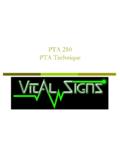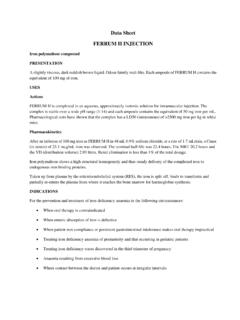Transcription of CPR for the Professional Rescuer with AED and Standard ...
1 CPR for the Professional Rescuer with AED and Standard First Aid Review Sheet to ECC Guidelines 2010 The American Red Cross (ARC) program reflects the 2010 First Aid Guidelines and Consensus on Science for CPR and Emergency Cardiovascular Care (ECC). This summary sheet will assist you in preparing for your annual review in the Professional Rescuer (adult, child, infant CPR) with AED (Automated External Defibrillator) and Standard First Aid challenge program. During an emergency, you will provide care based on the skills you are certified in. If another person is using different techniques to provide care to a victim it does not mean they are doing that skill wrong, they may be providing a certified different Standard of care.
2 Do not attempt to teach anyone the skills you are certified in. Things to remember: For all victims one person CPR cycle is 30 compressions to 2 breaths Two person CPR for adult cycle is 30 compressions to 2 breaths Two person CPR for child and infant is 15 compressions to 2 breaths Pulse check for adult and child is carotid artery (Neck); for infant brachial artery (Arm) Child is 1yr to 12yrs; an Adult is 12 yrs. and over for rescue/care techniques Conscious Check of victim is guided by: (see FA) Cardiac Chain of Survival: Early Recognition, Access to 911, Early CPR, Early Defibrillation, Early Advanced Medical Care Emergency Medical Services System The emergency medical services (EMS) system is a network of community and medical personnel that provides care to victims in medical emergency situations.
3 The system includes six resources: 1. Recognition, response and care by lay responders 2. Early activation of EMS system call 911 3. Professional Rescuer care 4. Pre-hospital care provided by advanced medical personnel 5. Hospital care 6. Rehabilitation Preventing Disease Transmission Rescuers will practice Standard precautions while providing care to victims to prevent the transmission of blood born pathogens (BBP). Precautions include the use of personal protective equipment, hand washing and engineering and work practice controls. These practices are designed to break the chain of transmission (Pathogen Present, Sufficient Quantity, Susceptible Host & Correct Entry Site).
4 If any of these conditions are not present or prevented the infection will not occur. Checking the Unconscious Victim: Adult-Child-Infant Size up the Scene Check the scene: Is the scene safe? / How many victims are there? / How could the accident have happened? Are there bystanders who can assist? Before checking the victim, put on protective gloves; (PPE's) & get a breathing barrier if available. Primary Assessment Check the Victim: Do a tap and shout. If no response .. Summons More Advanced Medical Personnel / CALL 911. Open airway, (head tilt / chin lift) Look-Listen-Feel for breathing and movement for no more than 10 seconds.
5 Pulse check and severe bleeding check for no more than 10 seconds; if victim has hypothermia, check for 30 to 45 seconds. Provide care as needed. 1 Revised 12/19/11 2 Giving Ventilations (Rescue Breathing): Adult Child and Infant Open airway (head tilt / chin lift) If after you check a victim, there is a pulse but no begin giving ventilations For adult victim, ratio is 1 ventilation every 5 seconds For child and infant victim, ratio is 1 breath every 3 seconds Position & seal the resuscitation mask open the airway and ventilate into the mask.
6 About every 2 minutes, remove breathing barrier & recheck for breathing and pulse for no more then 10 seconds If there is still a pulse but no breathing, continue ventilations If there is no breathing and no pulse, begin CPR Conscious Choking: Adult & Child Size up the scene, check the victim For adult, obtain consent to treat. For child, get permission from parent / guardian If victim is coughing encourage them to continue coughing If they stop coughing forcefully, summon more advanced medical personnel - Call 911 Stand beside the victim place your arm under victim's arm pit and across their chest to their opposite shoulder.
7 Lean victim over; using other hand, perform 5 back blows between the victims shoulder blades using palm heel - separate and distinct attempts - (for small child you may need to kneel.) Stand / kneel behind the victim, slide one foot between the victim s feet. Locate the victim s belly button and place fist just above the belly button, thumb side in Grab your fist with your other hand Give 5 quick abdominal thrusts, inward & upward: repeat sequence of 5 back blows & 5 abdominal thrusts until the object is forced out, victim begins to cough forcefully or victim becomes unconscious.
8 If victim falls unconscious, guide them to the floor and begin assessment for unconscious choking victim by checking mouth for foreign object. Unconscious Choking: Adult, Child & Infant If the chest does not clearly rise with ventilations Re-position, retilt the head and reattempt 2 ventilations If the chest still does not rise, assume the airway is blocked; FOR ALL VICTIMS - DO 30 COMPRESSIONS. For adult, compress the chest to a depth of at least 2 inches. For a child, compress to a depth of about 2 inches. For an infant compress to a depth of 1 inches. Compress at a rate of at least 100 chest compressions per minute; the 30 chest compressions should take about 18 seconds.
9 Look for foreign object. Open the person s mouth. (Remove Breathing Barrier.) Look in the victim s mouth, if you see an object, remove it with a finger sweep (if you see nothing do nothing) Attempt 2 ventilations: - if ventilations do not go in, repeat cycle 30 Compressions - Check /Sweep- 2 Ventilations - If ventilations go in; check the victim for breathing and pulse check Provide the care required based on check (rescue breathing, CPR or re-positioning & monitoring) Conscious Choking: Infant If possible, get permission from parent or caretaker to help While supporting the head & neck, position the infant face down on your forearm & support your arm on your thigh.
10 Keep the head lower than the chest. Using the heel of your hand, do 5 back blows between the infants shoulder blades Position the infant between both of your forearms, supporting infant s head & neck. Turn the infant face-up & position on opposite thigh. Place two fingers on the center of the breastbone just below the nipple line Give 5 chest compressions about deep Continue cycles of back blows and chest thrusts until the object is forced out or the infant becomes unconscious (If This Happens, Begin Procedure For Unconscious Choking) 3 Adult & Child CPR.















